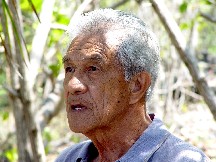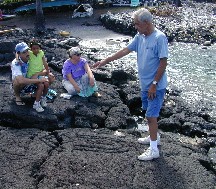Digital Collections
Celebrating the breadth and depth of Hawaiian knowledge. Amplifying Pacific voices of resiliency and hope. Recording the wisdom of past and present to help shape our future.
Kepā Maly, interviewer
William Kalikolehua Pānui was born at Ke‘ei, South Kona, Hawai‘i, on November 16, 1928. He was raised by his hānai parents Louis Kauanoekauikalikokahalaopuna Pānui and Annie Kahalulu Kauhi-Pānui. The Pānui-Kauhi lines have resided on the same land at Ke‘ei for many generations—the Pānui line descends from Na‘ea, an awardee of kuleana land in Ke‘ei (L.C.A. 10210 & 10376). Mr. Pānui graduated from Kamehameha School for Boys in 1947.
This is a brief excerpt of a fairly extensive interview conducted at Nānākuli, O‘ahu, by Kepā Maly of Kumu Pono Associates. Maly was commissioned by Kamehameha Schools to do research on Ke‘ei in 2002.
WP: Pi‘i mākou ma kēia alahele a i uka loa, i Wailapa. [pointing along trail that runs from village to uplands of Ke‘ei] (We also went up this trail to the uplands, to Wailapa.)
KM: Wailapa?
WP: ‘Ae, ‘o ia ka inoa. He māla kalo kā mākou i Wailapa. (Yes, that’s the name. We had our taro gardens at Wailapa.)
KM: Aia ma uka o ke Alanui Aupuni? (There above the Government Road?)
WP: Ma uka o ke alanui ma uka. (Above the upper road.)
KM: Pehea, he mile paha? (About a mile, perhaps?)
WP: [thinking] Hapa mile wale nō. (Half a mile.)
KM: A ‘o Wailapa ka inoa? (And Wailapa is the name?)
WP: ‘Ae. Ho‘olimalima ‘ia ka ‘āina mai . . . ma mua o Pihopa. (Yes. The land was leased from . . . before from Bishop.)
KM: ‘Ae.
WP: Ho‘olimalima ‘ia ka ‘āina, a ma laila mākou e hele ai a kanu i ke kalo, mai‘a maoli. (The land was leased, and there we went to plant taro and native bananas.)
KM: Hmm. He aha ke ‘ano o ke kalo? (What kinds of taro?)
WP: He kalo lehua kekahi, he kalo mana. (The lehua taro was one, and the mana taro.)
KM: ‘Ae. He mana ‘ele‘ele? (Yes. The mana ‘ele‘ele?)
WP: Mana ‘ele‘ele. ‘O ke kalo mana, ‘a‘ole i hana ‘ia ka poi. (Mana ‘ele‘ele. The mana taro wasn’t made into poi.)
KM: Hmm. Table taro.
WP: ‘Ae. Pu‘upu‘u kēia. (Yes, this one is lumpy.)
KM: ‘Ae. Ua mo‘a a ‘ai wale? (Yes, so cooked and eaten only?)
WP: ‘Ae, ‘ai wale ‘ia. Ka lehua, ‘o ia ke kalo i ku‘i ai no ka poi. (Yes, just for eating. The lehua, that’s the taro that was pounded into poi.)
KM: ‘Ae. A he aha ka mai‘a? (Yes. And what kinds of bananas?)
WP: Nui nā ‘ano mai‘a. ‘A‘ole au maopopo i nā inoa o nā mai‘a. (Many different kinds of bananas. I don’t know the names of the bananas.)
KM: ‘Ae.
WP: Nui nā mai‘a. Nā mai‘a Pākē, kapa ‘ia kahi ‘o ka mai‘a Pākē. A nunui ka mai‘a. (A lot of bananas. Chinese bananas, one type was called the Chinese banana. And the bananas were big.)
KM: Hmm.
WP: Ho‘omo‘a ‘ia i loko o ka imu. (Cooked inside the imu.)
KM: ‘Ae. Kūkū, e kala mai, i ke kanu ‘ana o ke kalo, ‘a‘ohe wai, kalo malo‘o? (Yes. Kūkū, pardon me, in the planting of the taro, there was no water, dry land taro?)
WP: ‘Ae, kanu malo‘o. (Yes, planted dry.)
KM: Ua hana pu‘e paha, a i ‘ole ‘umoki, mākālua? (Were mounds made, or planting holes?)
WP: He lua. (Holes.)
KM: A kīpulu ‘ia? (And mulched?)
WP: ‘Ae. ‘Oki ‘ia ka mau‘u ma ka ‘ao‘ao a komo i loko. (Yes. The grass was cut on the sides and put in.)
KM: ‘Ae. Pehea‘o Wailapa, he ulu ‘ōhi‘a paha o luna? (Yes. And how was Wailapa, an ‘ōhi‘a grove overhead?)
WP: ‘Ae, he ‘ōhi‘a. (Yes, ‘ōhi‘a.)
KM: Ua waiho kekahi o nā ‘ōhi‘a, a i ‘ole ‘oki ‘ia? (Were some ‘ōhi‘a left, or were they cut?)
WP: Waiho. (Left.)
KM: No ka mea, he malu? (Because of the shelter?)
WP: ‘Ae, māmalu. Kēlā ‘āina ma uka, ‘o Wailapa, he ma‘ū, ‘āina ma‘ū. (Yes, shelter. That upland section, Wailapa, was damp, it’s a moist land.)
KM: ‘Ae. Kind of boggy, wet kind?
WP: ‘Ae. Iho mai ka ‘ohu i nā lā a pau. (The mist comes down every day.)
KM: ‘Oia? (Is that so?)
WP: Every day.
KM: Iho mai, he kēhau paha? (So the kēhau comes down?)
WP: Kēhau, ‘ohu kēhau. So that’s what keeps the area damp.
KM: That’s right, that’s how it survives. Pehea, i kou wā li‘ili‘i ua lohe paha ‘oe i kou pāpā, a i ‘ole kou kūpuna . . . ma mua o ke kanu ‘ana pule paha lākou? (How about in your youth, did you hear your papa or your grandparents . . . before planting, did they pray?)
WP: ‘Ae pule! Pule mau lākou ma mua o nā hana a pau. Hana like ‘ole. (Prayed, yes! They always prayed, before every task. All different tasks.)
KM: ‘Ae.
WP: Ma mua o ka hana ‘ana, pule. (Before working, pray.)
KM: ‘Ae. So ma mua o ka lawai‘a ‘ana? (Yes. So before fishing?)
WP: Ma mua o ka lawai‘a ‘ana, ma mua o ke kanu ‘ana, ma mua ka hele ‘ana, mai ka home a hiki i ke alanui. (Before fishing, before planting, before traveling, from the home to the trail.)
KM: ‘Ae, pule mau. (Yes, always praying.)
WP: Pule mau. (Always praying.)
KM: Hmm, mea nui kēlā no ‘oukou? (This was an important thing for you?)
WP: ‘Ae. Ko mākou ‘ohana, māua me Pāpā, me Māmā, a‘o ‘ia wau, kakahiaka, he ‘ohana. (Yes. Our family, us two and Papa, with Mama, taught me, in the morning, we have family prayer.)
KM: ‘Ae, pule ‘ohana. (Yes, family prayer.)
WP: Ahiahi, pule ‘ohana, i nā lā a pau. A i ka hele ‘ana, ma mua o ka hele ‘ana i kahakai, ma mua o ka hele ‘ana ke ala hele paha, pule. (In the evening, family prayer, all of the days. And in traveling, before going to the shore, before going on the trail, pray.)

photo credit: Kepā Maly
Uncle Bill Pānui

photo credit: Kepā Maly
Uncle Bill points out petroglyph features while on a walking tour along the shore between Kūlou-Palemano and Ke‘omo, Ke‘ei, South Kona, October 28, 2002. (Left) Jeff Melrose, a planner with Kamehameha Schools Land Assets Division, and daughter; (Center) Kumu Hula Namahana Pānui, Uncle Bill’s wife; (Standing) Uncle Bill Pānui.